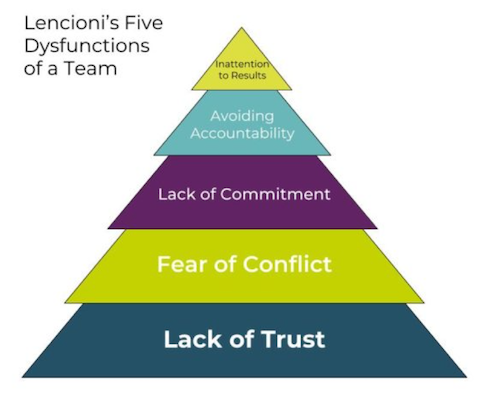Why the perception that the scope of team dysfunctions is confined to just five represents a grave misconception that needs urgent correction. This prevailing belief undermines the multifaceted nature of team dynamics, potentially obscuring the broader spectrum of challenges that can impede team success.
Is your team failing to function well despite fixing the common five dysfunctions of a team? Today is your lucky day. In this blog, I will share my fortuitous discovery, which will give you an insight into other team dysfunctions you may have overlooked.
Recently, I had the idea to write a blog article on team dysfunction. Just like everyone will do, I decided to research the keywords to find out what people out there thought about team dysfunctions. I started by typing “Team dysfunction” on Google, and to my surprise, at least all the results in the first five pages were based on “The Five Dysfunctions of a Team” by Patrick Lencioni.
I was surprised because this didn’t match my expectations. In my mind, I expected to find different sources or a variety of viewpoints on team dysfunction. I was shocked to be the only one with a unique perspective on such a sensitive subject that has troubled many organizations. Don’t get me wrong, I read The Five Dysfunctions of a Team back in 2002, and it was one of the best books on team dynamics that I stumbled on. I have used it for my coaching ever since. However, what was shocking was the impression my Google search results gave me 20 years later. With most of the answers based on the book of Patrick Lencioni, I felt that Google was telling me: “There are only Five Dysfunctions of a team.” A belief that most people have adopted.
Why could people believe that there are only five dysfunctions in a team?
We cannot take away the credit for the book being well written. The choice of Patrick Lencioni to present the concepts as a fable with examples makes the story very captivating and easy to remember. Like every good story, people have shared and recommended the book to others. I remember that I got the book on the recommendation of my friend Philipe Sarrazin. Word of mouth, the excellent marketing of the book, the services around the book, and the good SEO made it possible to get the impression that there are only five dysfunctions in a team. To the defense of Patrick Lencioni, I should mention that I have never read anywhere that he stated there are only five dysfunctions in a
group.
The situation reminds me of the story of the monkeys isolated in a room with a banana placed on top of a ladder.
As the story goes, the monkeys were sprayed with cold water as soon as one monkey tried to climb the ladder. Quickly, the monkeys learn that they should not climb the ladder; otherwise, they will be sprayed with cold water. The monkeys stayed away from the ladder when the cold water was removed because of the initial experience.
When one of the monkeys was replaced by a new one, the new member tried to climb the ladder, and the other monkeys beat him up to stop him. When a second monkey is replaced, he, too, is assaulted by other monkeys, including the first replacement, while trying to climb the ladder. This goes on until all the monkeys that started the experiment were replaced.
Now the monkeys do not attempt to climb the ladder, and if anyone tries to climb, the others punish him without knowing why climbing the ladder is prohibited.
It seems that with the success of the book of Patrick Lencioni, progressively, the ranking algorithm of Google, we have been conditioned to believe that there are only five dysfunctions of a team.
What are the Famous 5 dysfunctions of a team?
According to Patrick Lencioni, there are five fundamental dysfunctions that teams commonly struggle with.

- Lack of Trust – This causes a waste of time and energy because the team members are not open to each other and are reluctant to show their vulnerability. They hide their mistakes and weaknesses and don’t ask for help or assistance from each other.
- Fear of conflict – The team members refrain from raising issues that can cause fights with other team members even though they benefit the company. They choose harmony over constructive and passionate debates.
- Lack of commitment – The team members don’t commit or buy into the decisions. This leads to ambiguous situations, sources of conflict, and the team’s poor performance.
- Avoidance of accountability – The team members avoid holding each other accountable mostly because they haven’t bought into the company’s project.
- Inattention to results – The team members are not result-oriented and don’t put the company’s goals first in their minds but strive for personal success.
There is a gradation in these five dysfunctions. First comes the lack of trust, without which fear of conflict comes quickly. Without open discussions, it is hard for team members to commit. Without commitment, people don’t fully buy into a project, and it becomes impossible to hold them accountable. Getting team members to focus on achieving the company goals becomes impossible if the previous four conditions are not fulfilled. Great stuff, logical, and very practical! Nevertheless, I have observed when working with small businesses that there are other team dysfunctions.
What are the other Team Dysfunctions?

Per Merriam-Webster dictionary, dysfunction is an abnormal or unhealthy interpersonal behavior or interaction within a group. Based on the definition, it seems evident that something is wrong with limiting the knowledge about team dysfunctions to only five dysfunctions (even if they are considered essential dysfunction of a team). I believe there are many more dysfunctions, such as:
- Having an improper organizational structure
- Wrongly defined procedures and processes
- Poor communication among team members
- Poor training and coaching
- Missing team member – an incompetent person holds a post, or the position is not covered.
- Missing tools and resources
- Having the wrong people in the team
- Poor management
- Lack of recognition
- Rewarding the non-productive people
- Penalizing the productive people
- Lack of respect for the individual potential
- Undermining the well-being of team members
- Lack of clarity in company goals
- Misalignment of purpose between team members when creating a team
This list can go on and on. Add in this article’s comment the team dysfunctions you have encountered. Collectively, we will widen our perspective beyond the five dysfunctions of a Team by Patrick Lencioni.

Conclusion
The dysfunction of a team is a grey area, and the buck does not stop with the five dysfunctions of a team, as identified by Patrick Lencioni. Although the book is an excellent contribution to the coaching team, the marketing success and Google algorithm have misled many into believing that there are only five team dysfunctions.
To impact productivity levels significantly, entrepreneurs and team leaders need to open their minds to the possibility of exploring other team dysfunctions.




